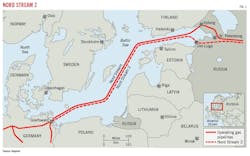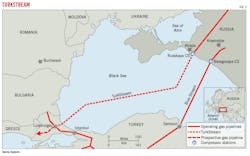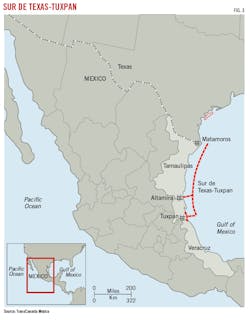Subsea pipeline projects advance in 2018
Even with offshore field development having slowed in the wake of the 2014 oil price collapse, a variety of subsea pipeline projects are underway. Each meets producers' need to rationalize the paths by which their hydrocarbons get to market, some of the larger natural gas projects taking land-based production to land-based consumers even as growth at both ends of the LNG market accelerates.
What follows is a regional breakdown of the more significant offshore pipeline projects.
Europe
Nord Stream 2 is a 1,200 km, 55-bcmy natural gas pipeline system crossing the Baltic Sea from Russia to Germany (Fig. 1). It will use 48-in. OD pipe following roughly the same path as Nord Stream, placed into service by Gazprom in 2012 and operating at 93% of its own 55-bcmy capacity.
Nord Stream in January 2018 received the construction and operation permit required to lay roughly 55 km of pipe through German territorial waters to landfall near Greifswald. Nord Stream expects to start construction in 2018. But new legislation in Denmark could prohibit construction in its territorial waters and route alternatives are being developed.
More than 70% of the roughly 200,000 pipe joints required for the project had been produced as of January 2018. Allseas will perform pipelay.
Statoil SA is building two pipelines to export production from its Johan Sverdrup development to shore. Gas will travel 156 km through 18-in. OD pipe to a hot-tap connection to the Statpipe system and continued shipment to Karsto. Oil will use a 283-km, 36-in. OD pipeline to reach Mongstad. Saipem's Castorone will perform pipelay in 2018, using pipes fabricated in Japan by Nippon Steel & Sumitomo Metal Corp.
DEA Norge AS will move gas produced at its Dvalin field to the Heidrun development via 14.9 km of 12-in. OD pipe, from which it will travel another 7.5 km to a tie-in with the Polarled trunk line. Dvalin production is expected to begin in 2020.
In an effort to expand and diversify export routes for its natural gas to Europe, Gazprom is building the TurkStream pipeline across the Black Sea from the Russkaya compressor station near Anapa to Luleburgaz, Turkey (Fig. 2). The 1,090-km TurkStream will follow the route of the once-planned South Stream pipeline for 660 km and a new 250-km corridor toward European Turkey for the balance of its subsea route.
Allseas Pioneering Spirit is laying the 32-in. OD pipe, having reached Turkish waters in November 2017. Gazprom expects the first of two 15.75 bcmy strings to enter service in 2019, supplying domestic Turkish demand. Gas from the second string will continue to southern and southeastern Europe.
The 878-km Trans Adriatic Pipeline (TAP) will transport natural gas sourced from the Shah Deniz II field in the Caspian Sea through an interconnection with the Trans Anatolian Pipeline (TANAP) at Kipoi on the Greek-Turkish border, crossing Greece, Albania, and the Adriatic Sea (115 km) before landfall in southern Italy. The offshore section will use 36-in. OD pipe, the onshore 48. First gas deliveries to Italy are targeted for 2020. Construction was two-thirds complete as of February 2018. TAP is owned by BP (20%), SOCAR (20%), Snam (20%), Fluxys (19%), Enagas (16%), and Axpo (5%).
An EU-funded study is underway regarding building a 159-km natural gas pipeline between Gela, Italy, and Delimara, Malta, connecting the island nation to the European gas grid via Sicily. The 22-in. OD pipe would move 2 bcmy, with a planned construction start in 2020 allowing first shipments by 2024. Malta is also studying the feasibility of building LNG bunkering infrastructure in conjunction with the project.
Middle East
At least two projects are under consideration to move gas from the Leviathan field offshore Israel and Cyprus to European markets. The first of these is IGI Poseidon SA's Eastern Mediterranean (EastMed) pipeline project. The 10 billion cu m/year (bcmy) system would move produced gas to Cyprus for processing before shipping it to Greece via Crete (which would extract 1 bcmy). Israel and Turkey are also negotiating a 10-bcmy pipeline to move Leviathan gas to Turkey and, via interconnection with TANAP, the European gas grid. The line would use 292 miles of 24-in. OD pipe.
Saudi Aramco in November 2017 signed agreements totaling $4.5 billion for assorted oil and gas projects. Included among these were what Aramco terms free flow pipeline packages allowing an early start to development of the Haradh gas increment program. The packages will total 450 km of pipeline, installed by early 2019 to deliver 290 MMscfd of free-flowing gas from Haradh field to Hawiyah gas plant and allow sustained production until compression plants are complete. China Petroleum Pipeline Co. will complete the work.
Abu Dhabi-based National Petroleum Construction Co. will install 25.5 km concrete-weight coated 30-in. OD trunkline between the new TP-21 platform in the Persian Gulf and the onshore Safaniya GOSP-1 gas-oil separation plant.
Saudi Aramco and Bahrain Petroleum Co. (Bapco) in 2018 plan to finish work on a 350,000 b/d crude oil pipeline. The line will move Saudi crude to Bahrain for refining, replacing an older 230,000 b/d line. The expansion coincides with expansion of Bapco's Sitra refinery. The pipeline will use a variety of pipe diameters (12, 18, and 22-in. OD) over its 115 km, 74 of which will be on land and the other 41 offshore in the Persian Gulf.
National Iranian Gas Export Co. is studying building a pipeline to Oman to export natural gas for both consumption in Oman and conversion to LNG. The 380-km pipeline would feature a 180-km offshore stretch. A gas supply agreement between the two countries calls for shipment of 28 million cu m/day, roughly two-thirds of which would be consumed locally. Initial gas flows planned for 2019 depend on the start of construction.
The Americas
TransCanada Corp. and Sempra Energy's Sur de Texas-Tuxpan natural gas pipeline will move 2.6 bcfd of US-sourced gas to Mexico using a subsea route beginning off Brownsville, Tex., and Matamoros, Mexico, and running south to Altamira and Tuxpan (Fig. 3). It will supply Comision Federal de Electricidad (CFE) power generation plants with fuel. Gas will feed into the pipeline from a line between the Agua Dulce hub in Nueces County, Tex., and Brownsville. The line will also interconnect with the Tuxpan-Tula pipeline to supply CFE powerplants to the west. It will use 500 miles of 42-in. OD pipe. Construction began in Altamira in May 2017 with an estimated completion time of 30 months.
Williams Cos.' Northeast Supply Enhancement natural gas project includes a 23.5-mile, 26-in. OD loop into NY waters of Raritan Bay from Middlesex County, NJ. Williams subsidiary Transco will operate the pipeline as part of its system and expects to have it in service in time for the 2019-20 winter heating season.
BP Trinidad & Tobago (BPTT) will use a 21-km, 26-in. OD pipeline to export up to 600 MMcfd of dry natural gas from its Angelin project to the 14.8-mtpy Atlantic LNG plant in Point Fortin, sending liquids to the Galeota terminal. Angelin lies in 65 m of water. Pipeline construction is expected to be complete in 2019.
Other projects
A few other large projects are in various stages of discussion but have not yet moved to development. Edison SPA reports the 8 billion cu m/year (bcmy) Galsi pipeline delivering gas from Algeria to Italy as expected to go on stream in 2018. A feasibility study on the 890-km pipeline was completed in 2005 but work on the system has yet to begin. The system would include two sections: an international section from El Kala, Algeria, to Porto Botte in southern Sardinia (310 km) and a domestic section running overland from Porto Botte to Olbia (300 km) and subsea from Olbia to Piombino, Tuscany (280 km).
Edison says the leg between Algeria and Italy would be the deepest subsea pipeline ever built, with a maximum depth of 2,885 m.
Two offshore pipeline projects would compete to bring gas from the Middle East to India: one starting in Iran, the other in Oman. The 1,200-km pipeline from Iran would largely parallel the shoreline between the two countries and serve as a substitute for the onshore Iran-Pakistan pipeline which India pulled out of under US pressure. Gazprom has expressed interest in building the pipeline, but would like to supply gas to Pakistan as well via Gwadar.
South Asia Gas Enterprise (SAGE) envisions building a 1,300-km, 1.1-bcfd capacity pipeline through deep water between Oman and India. Construction between a compressor station in Oman and a terminal in Gujurat, India, would take 10 years. Iranian gas sourced from Chabahar could also be shipped through this pipeline.
Talk of building a pipeline between Oman and India has been occurring since at least the mid-1990s (OGJ, Aug 1., 1994, p. 27).
The Morocco-Nigeria Gas Pipeline (MNGP) would carry Nigerian natural gas to Morocco via an offshore route beginning in Ghana as an extension of the already-operating West Africa Gas Pipeline. The roughly 4,000-km pipe is discussed as a replacement for the long-muted Trans-Saharan Gas Pipeline to provide a non-LNG alternative for moving Nigerian production to European markets.

Christopher E. Smith | Editor in Chief
Christopher brings 27 years of experience in a variety of oil and gas industry analysis and reporting roles to his work as Editor-in-Chief, specializing for the last 15 of them in midstream and transportation sectors.


